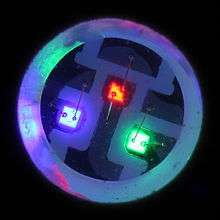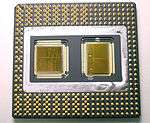Die (integrated circuit)
A die in the context of integrated circuits is a small block of semiconducting material, on which a given functional circuit is fabricated. Typically, integrated circuits are produced in large batches on a single wafer of electronic-grade silicon (EGS) or other semiconductor (such as GaAs) through processes such as photolithography. The wafer is cut (“diced”) into many pieces, each containing one copy of the circuit. Each of these pieces is called a die.
There are three commonly used plural forms: dice, dies, and die.[1][2]
Images
-

Single NPN bipolar junction transistor die.
-

Close-up of an RGB light-emitting diode, showing the three individual silicon dice.
-

A small-scale integrated circuit die, with bond wires attached.
-

A VLSI integrated-circuit die.
-

Two dice bonded onto one chip carrier.
-

The "naked" die without chip carrier of a Cell processor.
-

Intel Xeon E7440 die, mounted on heat spreader. Die is 22×23 mm (506 mm2), and contains 1900000000 transistors.
See also
- Integrated circuit design
- Semiconductor fabrication
- Wafer dicing
- Die preparation
- Chip carrier
- Wire bonding and Ball bonding
- Semiconductor intellectual property core – functionality block, that can be mixed with others
References
- ↑ John E. Ayers (2004). Digital Integrated Circuits. CRC Press. ISBN 0-8493-1951-X.
- ↑ Robert Allen Meyers (2000). Encyclopedia of Physical Science and Technology. Academic Press. ISBN 0-12-226930-6.
External links
- Wedge Bonding Process on YouTube – animation
- Industrial Bonder on YouTube – the video shows bonding not brazing
| Wikimedia Commons has media related to Integrated circuit dies. |